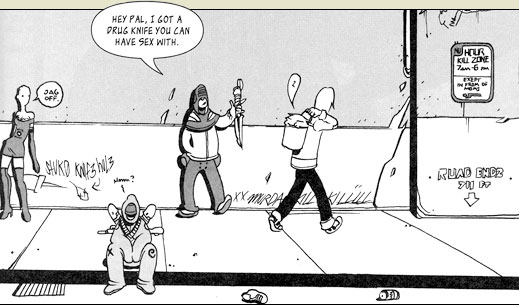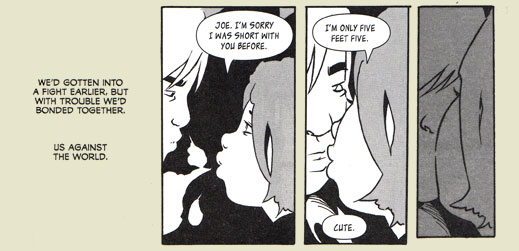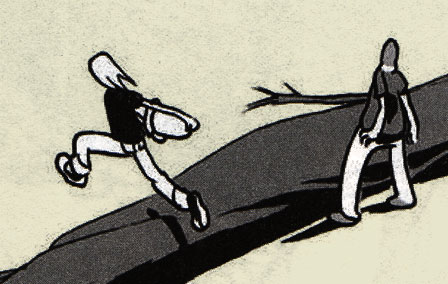King City
I've written before about expectations and how they cheat us of our reading experiences. Whether a positive or negative bias, these prejudices do unquestionable damage to the natural formation of opinion. A strong positive predisposition toward a book can push us to massage problems in a work to reflect our existing good will toward it—or, if the work too abruptly veers from our expectations, those expectations can lead to a sense of betrayal that wouldn't otherwise come about. A negative feeling toward a book can likewise either sour us unfairly toward the work or too easily endear us when things turn out better than we might have guessed.
And this isn't just a dynamic that exists before a book is opened. Expectation is interlaced throughout one's experience of a story in a manner both complex and largely unpredictable. What we expect of a book is a force that plays in every moment of a book's consumption, from taking in its cover to its method of introduction to its characterization to those characters' arcs to plot points along the way to its use of thematic elements to its climax to its conclusion. And to any number of other parts and pieces along the way. While reading a book, our expectations will naturally shift as we assimilate new information with our experiences and awareness of other stories and formulae.
So while we may try to give books a fair shake, it's impossible to approach things from an entirely neutral vantage. This is all very elemental critical theory of course and probably doesn't surprise a single one of you. I only mention it so that you'll be well on alert to my own predispositions in regard to King City.

Among the myriad tastes and experiences that influenced how I would approach reading King City, there were two major (and conflicting) things that exerted some force me. The first was the excitement/praise cycle that caused me to buy the book. If it wasn't for tremendous word of mouth, I wouldn't have been aware of King City in the least—let alone have been persuaded to spend of my limited budget to secure a copy. That right there is the kind of good feeling toward a book that I mentioned earlier, usually a boon but sometimes an albatross. In any case, I was excited for King City when the package arrived in the mail. Opening the book, however, led immediately to a sense of betrayal, as Brandon Graham's visual sense conjured a whole host of predispositions—none of which were conducive to a just approach to his work.
So I took a couple weeks to let those dueling expectations dim before I read a single page of King City. I think that was probably the right decision.
King City is a wonky, sly-futuristic extrapolation of a ton of implausibilities caked in that kind of alt-formal art style I (rightly or wrongly) associate with a skate-punk, indie DIY aesthetic. It's the art style that made me put down the book for two weeks. Generally, this visual method means cluttered, cacophonous pages filled with too much Stuff and disastrous visual storytelling. The characters are cartoony and not always super consistent. There's nothing necessarily wrong with the style save for the fact that I just don't have the patience for it.
But Graham's work in King City, though often busy and often manic, surprised me by being easy to follow and sometimes even a raucous joy to experience. There's a lot going on in this book both visually and narratively, but it doesn't bog down in overly detailed renditions of scenery. It may be that the importance of King City as its own kind of character gives meaning to all those flourishes that would otherwise be decorative trivialities.

While King City is principally concerned with Joe, a spy-thief and cat master, and his feline companion Earthling, the city he's returned to on Page 1 is nearly as important. King City in Graham is like L.A. in Chandler or Tokyo in Murakami or New York in Auster—only hopped up on two fistfuls of crazy. The city is populated by ninjas, mercenaries, spies, hoods, thieves, cults, aliens, and weirder things. There are secret passages into even the most mundane places. There are hideouts and tentacles and drugs made from humans. And puns. There are a lot of puns. If puns aren't your thing, then King City is not your thing. For that matter King City might not be your thing either. A knack for wordplay may be low-ball humour, but that's only tip-of-iceberg here. Graham has built a world that, while thriving on sex and violence, glories more than anything in a sense of humour and comic timing. Personally, I found very winning the particular joy Graham exhibits in giving his characters the stage and ability to make so consistently with the funny.
So far as story is concerned (and it really isn't too concerned), King City reflects on cat master Joe as he returns from a couple years away. He had fled the city after a bad break-up and holed up on The Farm, where he learned the Way of the Cat and received his boon companion, Earthling, whom he carries around in a bucket. Joe is doing some sneak-thief work to ingratiate himself to the locals while he tries to find his feet in a city that's changed while he's been away. Meanwhile, his old friend Pete Taifighter (who wears constantly from a collection of wrestling masks) has decided to cross his employers Transporter-style after having grown a conscience. Meanwhile still, Anna Greengables (Joe's ex) is painting graffiti moustaches and worrying over her drug-conflicted ex-mercenary boyfriend, who's got bad PTS from the last Xombie war. And then, on top of that, there's a death cult and tentacle monster and the fate of the world. Or at least King City.

It's a good mix of everything and kitchen sinks and bathroom scales and old-timey refrigerators. King City boasts a healthy menagerie of wild abandonments and ridiculousness and tempers it with a lot of heart. More heart than I would have expected from something that wallowed in so much indie-skater-punk aesthetic. Brandon Graham, in a word made of three words, defied my expectations. In a good way. Or maybe in the best way. King City was a wonderful experience.
Note
If there's one major issue with the book (and by major, I really just mean a triviality that's kind of a shame), it's with the printing. Most pages are crisp and lovely, but a good handful show easily-visible jpeg artifacting. It gives the linework on those pages a blurry feel that dims the enjoyment slightly. Below, I've provided an example of what I'm talking about. I've upped the contrast a little to take into consideration monitors that are too bright:

Good Ok Bad features reviews of comics, graphic novels, manga, et cetera using a rare and auspicious three-star rating system. Point systems are notoriously fiddly, so here it's been pared down to three simple possibilities:
3 Stars = Good
2 Stars = Ok
1 Star = Bad
I am Seth T. Hahne and these are my reviews.
Browse Reviews By
Other Features
- Best Books of the Year:
- Top 50 of 2024
- Top 50 of 2023
- Top 100 of 2020-22
- Top 75 of 2019
- Top 50 of 2018
- Top 75 of 2017
- Top 75 of 2016
- Top 75 of 2015
- Top 75 of 2014
- Top 35 of 2013
- Top 25 of 2012
- Top 10 of 2011
- Popular Sections:
- All-Time Top 500
- All the Boardgames I've Played
- All the Anime Series I've Seen
- All the Animated Films I've Seen
- Top 75 by Female Creators
- Kids Recommendations
- What I Read: A Reading Log
- Other Features:
- Bookclub Study Guides










